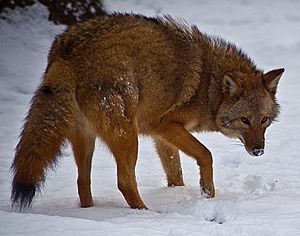Eastern coyote facts for kids
The eastern coyote is a wild animal found in North America. It's a mix of different dog-like animals, including coyotes and wolves. This special mix probably first happened in the Great Lakes area. Western coyotes started moving east and met the wolves there. This mixing was first noticed between the 1930s and 1940s. It likely happened after gray wolves disappeared from parts of Ontario, Labrador, and Quebec. This allowed coyotes to move into those areas and mix with the few wolves left. The eastern coyote is smaller than the eastern wolf but bigger than the typical western coyote.
What is it called?
This animal has a few names. Scientists sometimes call it Canis latrans var. People also know it as the eastern coyote, northeastern coyote, or even the coywolf.
Coyotes and wolves first mixed in the Great Lakes region. This created a huge area where these mixed animals live. In 2014, a DNA study looked at eastern coyotes. It showed their DNA is mostly from western coyotes (about 62%). They also have DNA from western wolves (14%), eastern wolves (13%), and even domestic dogs (11%). This mix of genes helps them live in both forests and places where people live.
Scientists think that male wolves usually bred with female coyotes. Also, male dogs likely bred with female coyotes. This is because the larger animal (male wolf or dog) usually bred with the smaller animal (female coyote). This mixing of genes has helped eastern coyotes adapt to new food sources, like white-tailed deer. Deer are very common in the United States. Having predators like the eastern coyote helps keep the deer population balanced.
In 2016, a group called the IUCN suggested that the eastern coyote should be seen as its own species. They proposed the name Canis oriens, which means "eastern canid" in Latin. They also suggested the common name "coywolf." This is because the eastern coyote looks and has genes that are unique. It also breeds with other eastern coyotes across most of its home range.
What does it look like?
Adult eastern coyotes are bigger than western coyotes. They usually weigh between 45 and 55 pounds. Female eastern coyotes are about 21% lighter than male western coyotes. Eastern coyote pups are also heavier when they are born. They weigh about 349–360 grams, while western pups weigh 250–300 grams. By 35 days old, eastern coyote pups are about 1,590 grams, which is 200 grams more than western pups. As they grow, eastern coyote pups get longer legs. Their teeth also grow in a bit differently and at a later time.
Eastern and western coyote pups are similar in how they act. However, eastern coyotes tend to fight less and play more. Eastern coyotes also become old enough to have babies later, usually around two years old. Western coyotes can have babies sooner.
Besides their size, eastern and western coyotes look quite similar. Both have ears that stand up, a straight and bushy tail, and a special scent gland on their tail. The eastern coyote can have four different fur colors. These range from dark brown to blond or reddish-blond. Gray-brown is the most common color. They often have reddish fur on their legs, ears, and sides.
Where do they live?
The eastern coyote lives across the eastern United States. You can find them in New England, New York, New Jersey, Pennsylvania, Ohio, West Virginia, Maryland, Delaware, Virginia, and Washington, D.C.. They also live in eastern Canada. This includes provinces like Ontario, Quebec, New Brunswick, Nova Scotia, Prince Edward Island, and Newfoundland and Labrador.
What do they eat?
Eastern coyotes eat many different things. They will eat whatever is available and easy to catch or find. They are known to eat everything from mice to moose. The Ontario Ministry of Natural Resources lists their main foods as rabbits, hares, and deer in the winter. In the summer, they eat small mammals, wild berries, birds, amphibians, and grasshoppers.
Their diet changes with the seasons. In summer, they might eat insects and berries. In fall and winter, they focus on small mammals. As winter gets harder, they might hunt larger animals like white-tailed deer. They often hunt in pairs. However, they more often eat deer that have been hit by cars or died naturally. Researchers found that in winter, only 8% of adult deer visited by coyotes were actually killed by them. The other 92% were deer that coyotes found after they had died or were badly hurt. The deer that coyotes did kill usually had serious injuries already. In spring, eastern coyotes often hunt fawns (baby deer).



